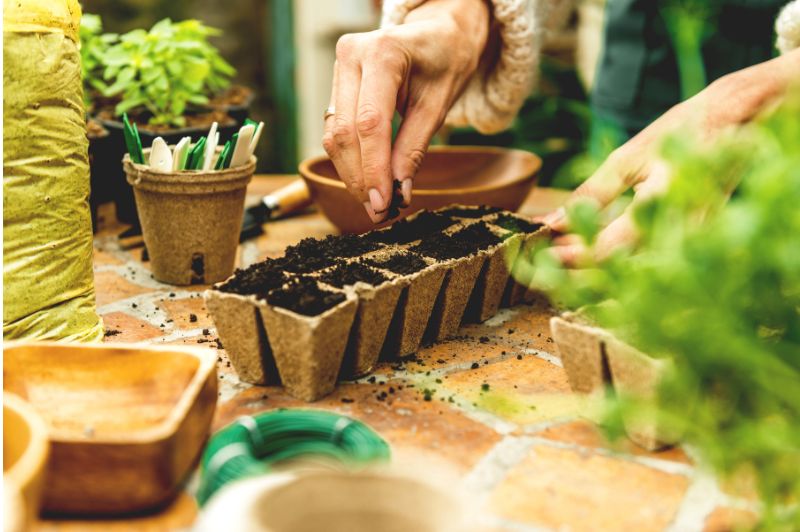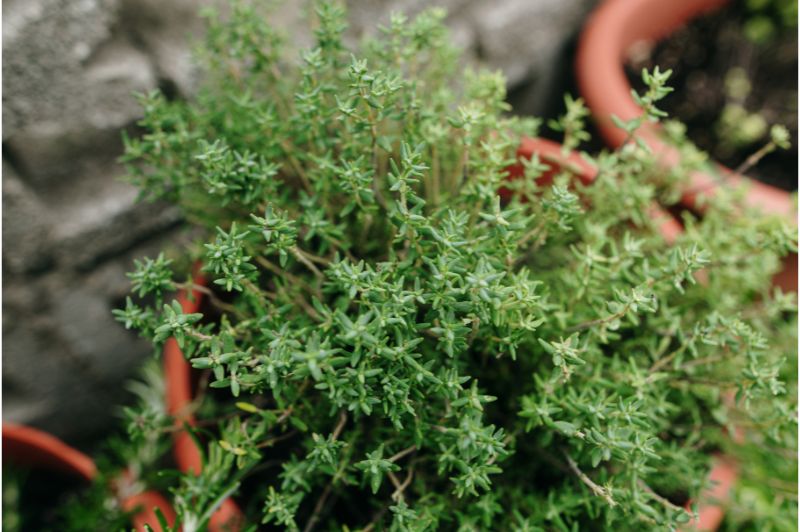
Growing your own time, whether from seed or a cutting from another plant, is a pretty easy process. But we have to take special care of it in its early stages.
Growing Thyme from Seeds
Here are the things you will need to get started:
- Thyme seeds
- Plant pot or pots with good drainage
- A good herb potting soil mix
- Pair of gardening gloves (optional)
- Small gardeners’ spade (optional)
- A grow light (optional)
We can pick up our thyme seeds at a nursery or anywhere that sells seeds. Thyme is common almost everywhere.

There are several varieties of thyme, the best one and the most common is just that, common thyme (Thymus vulgaris). This is the most widely used variety.
At the same time you buy your thyme, grab a bag of potting soil. Use a potting soil that has some moisture control, which protects your thyme from over- or under-watering. Thyme likes a well-draining environment.
Fill your planter to about 3 inches from the top of the container, give the container a bit of a tap on the floor to fill any air pockets; no need to compact the soil any more than this.
Use your finger or a stick to slightly scrape along the top of the potting soil, no more than 1/4 inch deep. The tiny thyme seeds barely need to be covered with soil to sprout. Create a few rows or circles, whichever pattern you prefer.

Now sprinkle the thyme seeds in the little shallow trench you made. Don’t worry if a few seeds fall close together. Thyme seeds are so small that it would take you forever to place them one at a time.
Cover the seeds with a light covering of soil and give them some water. Best to use a mister or a fine sprinkle of water so you don’t uncover or wash away the delicate seeds.
Place your planter in a sunny area by a window, and the planting process is done.
You only need to water when you see the soil is dry. Continue to use a light spray.
Once the plants have a few true leaves, they will need more sunlight to really thrive. If you don’t have a grow light indoors, consider planting a few of your seedlings in the garden. You can continue to grow thyme indoors next to a window, but it won’t truly thrive without adequate sun or supplemental light.
You might be asking why not just plant them directly outside. That’s a great question.
The answer is you can, definitely. In my experience, I have found that starting plants indoors allows them to become well-established before being transplanted to my garden, resulting in much greater success.
I also enjoy having a ready supply of Thyme close to where I am cooking, which is another reason to grow it inside. The best thing is to have it both on your kitchen windowsill and in your garden, why not?
The thyme seedling starts off quite delicate, but once it gets going, this plant is a force to be reckoned with.
Growing from Cuttings (Propagation)

If you have a friend who already has thyme growing or if you are lucky enough to live in a climate where it grows naturally wild, save yourself some money and grow your own plants by taking a cutting from an existing one.
To grow from a cutting, you will not require anything more than the cutting itself, your plant pot, and soil.
Just take a few small cuttings from an existing plant. It’s best to take a cutting from a woody stem. Cut below the nodes you will notice on the stems; this is where the new leaves will start to grow.
Trim all the leaves off below the node and stick the stem into the soil. Make sure the soil is slightly damp; you will want to keep it this way. Place your planter in a warm, shady area, and your thyme is on its way.
Caring for your Thyme at all Stages of Growth
The only critical time for thyme is when it is at that delicate seedling stage. The things to avoid are:
- Direct hot sunlight
- Over watering
- Under watering
- Any animals that might trample it
Watch out for these few things, and you will have a great crop of thyme that will last for years.
The beautiful thing about thyme and growing it is that, as with most herbs, its fragrance deters predatory insects. This makes it an easy plant to care for.
In addition, Thyme makes a great companion plant for other vegetables you might have that are more prone to invasion by insects. Your thyme will actually help keep the bad bugs away.
That’s all there is to getting started on growing your own thyme. Once you have a nice thyme bush about 10 inches around and about 3 or 4 inches high, start cutting some of it and put it to use in your cooking.
You will soon realize how much nicer the fresh thyme out of your garden is than the dry thyme you buy at the supermarket.
Get started and have a good thyme!
